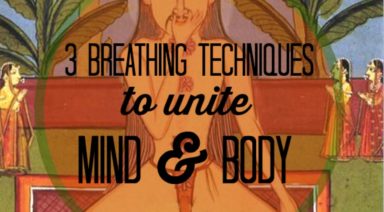Begin Hacking Your Way to a Solid Daily Meditation Practice

One day a sage and his students were meditating together. At one point the student noticed the teacher floating in the air.
Frustrated, he said to his teacher, “Master, I don’t understand why I’m not floating too. What is the difference between you and me that you can do this and I cannot?”
From his position aloft, the master looked down at the student and said, “Practice.”
How many articles, blogs, or social media posts have you read lately that start like the next sentences?
“A 2014 Harvard research study determined that meditation builds the brain’s gray matter in eight weeks. Grey matter, composed of neurons, makes up about 40 percent of the brain. More is good.”
Then they continue by citing more research.
“Meditation reduces anxiety, according to another study. Meditation reduces age and race bias — meaning that meditation could be an antidote to racism and prejudice — says a 2015 Central Michigan University study. According to the American Psychological Association, “mindfulness-based cognitive therapy [meditation] may prevent and treat depression.”
More research: Vast swaths of first-world societies struggle with self-acceptance, experiencing “body dissatisfaction.” Results of a 2014 study report that meditation increases “self-compassion,” meaning reduced “body shame,” and increased sense of self-worth.
And one more: The Mayo Clinic reported that a growing body of research suggests meditation may help manage symptoms of asthma, cancer, heart disease, high blood pressure, and irritable bowel syndrome, and offers methods such as guided, mantra, and mindfulness meditation as well as qigong and tai chi.
At this point, not making the effort to establish a meditation practice might be likened to not flossing your teeth. And the benefits, including emotional hygiene, addiction resistance, enhanced immune system function, etc., are so far-reaching, one might think humans require meditation for optimal function. Just the fact that meditation is proven to increase happiness should be enough to send us running, en masse, to our cushions. So why aren’t we all meditating like a nation of monks?
Good question. Consider this.
We like to imagine we’re “free” to do what we like.
Think again.
As adults, we’re free of parental regulation — yay — but if, when encountering friction, we give up on creating new habits, we’re slaves to our own resistance. This means we’re not free to easily embrace and integrate habits that dramatically increase our well-being and quality of life.
For many, failing to meet goals on the first few attempts means lost resolve. Initially, when we’re practicing our new thing, be it a musical instrument, a language, or maybe fencing, we feel solid and inspired. Sooner or later we miss a day because (pick your favorite): We didn’t practice but we’re tired and it’s time for bed. Or there’s a crisis. Or a distraction. Or we’re traveling. Or it gets harder and not as fun. Or boring. Or we weren’t in the mood, or we had a sick child, or we forgot (the most insidious). The rationales are infinite. A couple of “misses” can mean a loss of momentum.
Then we beat ourselves up a little (or a lot) and slide back into old routines, waiting for the next upswell of inspiration, the next urge for change, the next training or class, or in the case of meditation, the next weekend retreat. “Maybe a new method will do the trick,” we think.
If this doesn’t sound familiar, and you are someone who seamlessly integrates new disciplines into your life without missing a beat, skip the next section. Flawed mortals, read on.
The Resistance
We imagine we should be able to jump into something and stick long enough to achieve mastery. Somehow we don’t, even with the best intentions. Martial artists have a Japanese name for those who don’t get traction with new lessons; “kakan no fushigi,” or three-day wonder. This can be hacked.
When we give up, we assume it’s because we have a character flaw or missing part. We watch those with mastery, whether it’s figure skating, or an oil painting, or chess, or the Dalai Lama just sitting there, and imagine they have some extra ingredient we lack. Talent? Genius?
Some maestros train from childhood, like the Dalai Lama and most figure skaters. Some have a little “savant” wiring that gives them effortless abilities — the rain men and women of the world. Some, like Van Gogh, start later in life with no obvious talent, obsessively working their way to mastery at the exclusion of all else. And there are others who lovingly, persistently practice a craft or discipline until they reach mastery.
Why Do We Resist Regular Meditation?
The economy of energy is a powerful survival strategy. Think of leopards basking on tree limbs in the heat of the day. Nature hardwired us for survival in hostile environments, so we’re predisposed to conserve energy because we’ll need it to escape predators, chase down food, have sex, and protect and feed the results of the sex. Our DNA carries the impulse to be discriminating about anything that doesn’t contribute to survival, often resisting change that involves effort.
The software is another thing. Somewhere around age two, we discover the power of “no.” Behaviorists say “no” is a step toward gaining independence, confidence, and assertiveness, and outgrowing an infant’s helplessness. “It’s a phase,” as moms and dads have echoed through the millennia.
Eventually, we learn we can say “no” only so many times before there’s blowback. Parents have the final word, one way or another. But our “no” is never completely overcome — it gets sneaky. Behold, the birth of passive resistance.
Side note: Savvy salespeople and neuro-linguists know we will say “no” only so many times before we cave in. They’ll keep triggering a “no” response until the 2-year-old believes it has run out of rope, which is about the same time our adults ran out of patience — usually around the third or fourth “no.”
That defiant, vestigial 2-year-old is ours forever. It’s handy when we need to assert boundaries, but it also works in service of lazy, smart nature with its powerful resistance to change. Even “good” change. Because nobody’s going to tell our inner toddler what to do. Even us.
Sometimes the toddler runs the show. We recognize toddlers disguised as grownups all around us; the guy at work who resists planning and teamwork because of authority issues. The partner who passive-aggressively leaves dirty dishes in the sink. The housemate who won’t vacuum when it’s his or her turn. Anyone having a public tantrum.
The toddler may stir from his nap when we endeavor to acquire a new habit unconnected to survival, sex, or self-defense — like meditation. He says, “Nobody’s going to tell me what to do. Not even me.” The imp is a sophisticated master of all forms of indirect resistance; procrastination, ignoring, sudden urges for naps, seemingly unavoidable distractions, forgetfulness, loss of interest, and rationalization.
Meaningful change requires exertion, particularly in the early stages of establishing new habits. If we push through the kakan no fushigi (three-day wonder) stage, we achieve the freedom to enjoy the rewards of persistence over time. That kid can be hacked.
While meditation is often defined as “contemplation,” in the most practical sense, it is attention management. Everything in our environment is competing for our attention — and wherever our attention goes, our energy follows. Environmental or emotional cues can drag the untamed mind and attention around like a Rottweiler puppy dragging its owner at the other end of the leash. Are you willing to be at the mercy of your own reactivity?
If you “own” your own attention, you reclaim your energy and you can consciously decide where to place your awareness. The effort also brings the benefits noted above. Sovereignty over-attention is the entry-point to a lucid, awakened state. As the Buddha said, “A mind unruffled by the vagaries of fortune, from sorrow freed, from fear liberated — this is the greatest blessing.”
It Runs Deep
There’s another part that, when serious change is afoot, slams on the brakes hard enough to put us through the windshield (wear a seatbelt). It’s the thing that panics when we’re making a significant move toward waking up.
Imagine packing for a wholesome, healthy, two-week meditation retreat. You have finally said, “OK. This is it. I’m getting on this bus. I’m committing.” But as departure nears, this deep, silent part, sometimes called “ego,” knows it’s headed for the executioner’s block or is at risk of being seriously maimed.
It might throw irrational fears and anxieties across your path, like a sudden weird premonition of a car accident, or imagining a loved one becoming seriously ill while you’re gone, or your beloved pet running away in your absence. It might give you an odd sense you’ll never see your home again, or it could show up as a loud, simple “I DON’T WANT TO DO THIS.”
It could even be, “OMG. What if I’m gonna be kidnapped by a cult?” It often wears a disguise of “deep intuition,” and is responsible for most last-minute cancellations. Know that the intensity of the resistance is directly proportional to the potential richness and reward of the undertaking.
It doesn’t happen all the time, but it happens. Recognize it for what it is, and know it’s a clear signal you’re pointed in the right direction. The hack is to realize a profound change is on the horizon, and some part of you is pulling the emergency brakes. The first time is the most dramatic — it gets easier.
Where to Start — The Wind Up
One of the biggest challenges is how to begin a daily meditation practice. Have you decided on a method, or do you already have a technique? It can be samatha/vipassana, a.k.a mindfulness meditation; typically a technique of watching the breath and bringing wandering attention back to the exhale. You may choose a body-based method — tantric systems utilize and explore the body to tame the mind and wrangle attention, which can be likened to teaching a cat to “sit” and “stay.” According to the Buddha, “If the body is mastered, the mind is mastered.”
You can also train with a guided meditation focused on, for example, gratitude or the heart. Then choose an additional method — you’ll want more than one in your collection for your meditation-hacking project. It could be similar or radically different; just choose something that appeals to you.
If you already have a preferred technique, choose one more — you’ll need an alternative to hack a sustained practice. The choices are abundant. Nail down your techniques; understand the instructions and the methods before you start. The more energy and attention you put into this process, the higher the likelihood you’ll succeed. By doing so, you’re sending yourself (and your toddler) the message that you’re serious.
The Daily Meditation Sadhana Commitment — Down to Business.
“Sadhana,” a Sanskrit word, translates to effective in English, according to one source. Another source, Wikipedia, states, “Sadhana: literally ‘a means of accomplishing something.’” Yogapedia calls sadhana a “discipline of routine spiritual practice and the routine surrendering of the ego through activities such as meditation, yoga, chanting, or prayer.” The notion of ego surrender as “routine,” like a household chore, seems like an understatement, but so be it.
To hack the three-day wonder syndrome, first, adapt the “right view” of your sadhana practice by committing to a 30-day sadhana. Thirty days. That’s it. No more, no less. This is a “professional” approach, as opposed to a casual, “amateur” mindset that says things like, “I’m starting my meditation practice tomorrow. I’m going to do it every day for the rest of my life, and I’m going to practice two hours a day.”
When we casually make and break vows and commitments with ourselves, we weaken our resolve. Being casual leads to casualties; in this case your precious, life-changing sadhana commitment.

If you’re a beginner, pick a start date and commit to 15 minutes of practice once a day for the 30 days. If you’re an experienced practitioner, you may choose to go for a longer period, but know the 15-minute strategy is a valuable step toward establishing a sustained practice. If you’ve fallen off the bus in the past, this technique can build the habit muscle for a solid daily sadhana. You’ll be able to ramp up the length of your sessions soon, and you’ll be on solid ground when you do. If you do choose a longer time period, stick to it — just be reasonable. Right now we’re building consistency instead of strength or endurance.
If your toddler suggests that doing two sessions in one day will make up for a missed day, it’s trying to hack your hacking strategy. Ignore it.
Keep a notepad and pen or pencil In the area you’ve designated as your meditation space. On the pad, make a note of the technique you’re using, followed by “30 DAY SADHANA BEGINNING x/x/xxxx. Don’t add an end date.
On the first day of your sadhana, when you’ve completed your meditation session, write “Day 1” and put a check next to the number. If you like, you may add brief notes, but if you wish to write more, do it somewhere else. This is your activity log rather than a journal of reflection.
The next day, the same thing, but write “Day 2” and make a checkmark, and so on all the way to 30 days. Easy peasy, right?
Oops — You Missed A Day
That’s OK, there’s a hack for that. Here’s what to do.
First what not to do: No hand wringing. No guilt. No regrets. No beating yourself up, no drama, no punishment, no recriminations. No conclusions.
Next: The following day go to your meditation space to practice as you did before the miss. When you finish, in your log, write:
“Day 1.”
That’s it. Day 1. Reset. You’re starting again at day one. Doesn’t matter if you made it to day 29 before the miss. You’re now at day one. The essential point here is to sidestep laying a trip on yourself. Self-recrimination leads to a sense of failure, and a sense of failure leads to giving up — many of us already know our way around that drill. Just say to yourself, “Oh. OK. Reboot.”
When we refuse to be patient and compassionate with our own humanity, we have a tough time sincerely and authentically extending those attitudes to others. Condemning ourselves for blowing a day, or actually for any reason, is like hitting ourselves with a rock and wondering why we’re feeling pain. As the Buddha said, “You can search the entire universe for someone who is more deserving of your love and affection than you are yourself, and that person is not to be found anywhere. You yourself, as much as anybody in the entire universe, deserve your love and affection.”
When rebooting, drive a stake into the metaphorical ground by laying down the following condition: “No sleep before sadhana is complete.” If you have a morning practice, the condition is: “No food before sadhana is complete.” Then stick to it.
You’ve Achieved 30 Days of Daily Meditation!
You’ve reached 30 consecutive days! Now you can add an end date to your log. It doesn’t matter if it took six months to finish a 30-day sadhana — in fact, all the better — you persisted for six months. It’s about honoring the commitment and hanging in. You are no longer an amateur — you’ve had a taste of spiritual warriorship. Give yourself a hug and kiss the three-day-wonder goodbye. You’ve also demonstrated that you are not hostage to a cranky toddler; the imp has been put on notice that his or her reign is nearing an end.
Take a day off if you think you need it, but be ready to resume within 36 hours. If we take too much time off before beginning again, we risk losing the momentum created by the first sadhana, and we’re also given the scheming toddler extra time to refine a resistance strategy.
Perhaps by now, you have a sense of the benefits of regular meditation. There’s value in writing them down and considering how you’ve changed since starting. Feeling more at home with yourself? More relaxed? More acceptance of self and others? More cheerful for no reason? Less reactive? Whatever it is, make a few notes on your current reality. You’re writing a letter to your future self.
What Next?
In the words of the American swami Rudrananda, “The reward of work is more work.” You’re going to begin the next sadhana with your alternate method.
Maybe the toddler didn’t fuss during your first sadhana. Maybe you think you made a clean getaway. Your next step is another sadhana — and here’s the thing: When we unwaveringly commit ourselves to an initial sadhana, then back it up with consistent practice, our toddlers may surmise, “Hey, it’s only 30 days. No big deal.”
When we quickly follow with a new sadhana, the toddler might say, “Wait a minute. We just did the 30 days. Now we’re doing another? NO.” The toddler will use every minute of the time off to hone her resistance. Better to just get back on the cushion with an alternate method. Remember, it takes eight weeks for meditation to grow new grey matter in the brain — you’re halfway there.
The Second Method
Humans are prone to attenuation. In the simplest terms, if we do the same thing over and over again, we can slip into autopilot and let the initial inspiration and enthusiasm dissipate even though we show up and put in the time. Another reason; imagine going to the gym and repeating the same workout for three or four months — exercise is good, but without variation, it gets boring and muscle groups you’re not using are neglected.
The trick is to always be a newbie — a beginner. Even meditation masters continually cultivate shoshin, the zen term for “beginner’s mind.” This is the state of fresh curiosity free of prejudice. Think of the last time you were deeply absorbed in learning something you love — how delicious it was. That’s beginner’s mind.
By switching up your practice method, you re-engage beginner’s mind; you’re exploring a new technique and building more psychic “muscle” for adaptability and agility.
The Next Sadhana
Change it up and start anew — this round you’ll do 25 minutes, but this time tries putting a little skin in the game. Bring a bowl or container to your practice space. Each time you finish your daily practice, drop a dime or quarter or a dollar or more into the bowl. Pick a denomination, even if it’s just a penny, and drop one in the bowl at the end of every session.
Don’t rob the bowl to tip the pizza delivery guy, and let the toddler know if she behaves for the next 45 days, she may choose how to spend the money, even if it means you end up going out and buying a pair of fuzzy unicorn slippers or a few legos. Know if you make that deal, you must honor the terms.
You may choose to keep the cash, which is fine. Some practitioners view these dedicated coins and dollars as abundance magnets, and it’s gratifying to watch them accumulate. Consider how you’ll use the funds — a yoga retreat maybe?
When you finish your 45-day sadhana, look back at the notes you left yourself after the first 30-day sadhana. This may offer insight into how your practice and experience are deepening over time. Again, make some notes about your current reality to look back on from time to time.
One of the tricks for sitting comfortably with a straight spine is to be sure the hips are higher than the knees.
Tricks and Tools for Beginning and Sustaining Your Meditation Practice
Get a great timer. Meditation timer apps that feature a choice of tones (gong, singing bowl, wooden sticks) are proliferating online. Some are free. Others, like the original Insight Timer, are paid apps that include guided meditation libraries and practitioner communities. The Insight Timer also tracks daily practice over time with statistics and milestones.
If you’re challenged by longer sessions, i.e., drifting off or spacing out, the Insight Timer features customizable interval sounds that can be used to bring you back to the practice and keep you in the present moment.
If your body gets restless during sessions, try a little power yoga prior to practice. Even taking a walk before meditation can help center and calm the body. You may also need a different zafu or meditation cushion for sitting. Read more about choosing a meditation cushion here. One of the tricks for comfortable sitting with a straight spine is to be sure the hips are higher than the knees. This creates a stable distribution of weight and a good foundation, as the spine and neck naturally fall into the optimal position. It is completely acceptable to sit in a chair as long as the back is straight and the feet are flat on the floor, but again, be sure your hips are higher than your knees.
Being uncomfortable will not enhance your practice or experience. If a leg or foot starts to fall asleep, shift your body or stretch your leg out in front of you until the discomfort stops. When ready, return to your position. The approach, when you need to shift or move, is to do it deliberately rather than reactively. If something itches, and it doesn’t go away in a few seconds, scratch it. If you have an itchy rash or skin condition, treat it before you begin your session.
Bombarded by insistent, wandering thoughts? Put the tip of your tongue on the roof of your mouth. According to Tantric traditions, this closes the large internal channels of the subtle body and helps calm the mind.
To create a frame of reference for the experience of watching the mind free from physical distraction, a float tank session may help. These dark, silent isolation chambers are filled with body-temperature water with Epsom salts for buoyancy. A google search on “float tank” will return results that should include flotation therapy centers in your area.
After the 45-day sadhana is complete, go for a 100-day sadhana. This is the gold standard for committed practitioners. Setting 30-minute sessions for the 100-day period is optimal. You can go back to your original method or work with a new technique.
If you have followed through with these hacks, you now have a solid practice that has likely developed its own momentum. Be mindful, spiritual warrior — this phenomenal world, toddlers, and distractions will continually attempt to lure you back to sleep. The good news is — you’re awake and can track them with awareness.
Resources:
Daily Meditation with Rodney Yee offers a gentle yoga warm-up followed by breathwork. This program includes a morning and evening version.
Tantrik Micro Meditation Practices is a series of 13 meditation practices that can be done in five minutes or extended for longer sessions. Instructor Christopher Hareesh Wallis is a scholar, yogi, and expert in Tantric traditions.
Each Process of Awakening segment (seven episodes) includes teachings and applicable practices designed to be integrated into everyday life. The host, Kevin Courtney, has taught yoga and meditation since 2002.
Meditation 101 is a five-episode series designed to get practitioners started on the meditation path.
Which Type of Meditation Style is Best For You?

While some may think that meditation requires nothing more than sitting silently, it isn’t necessarily as easy as it seems. The commitment needed to practice every day coupled with the challenge to empty your mind of everyday stressors can be discouraging. However, it doesn’t necessarily need to be.
Meditation has been scientifically proven to reduce stress and anxiety, improve health, and increase happiness. However, the most essential aspect of meditation is appealing to your spirit. It is an entirely subjective practice and there is no right or wrong way to meditate. By practicing every day and finding a style that compliments your soul – you’ll not only experience the joy in meditation, but you might just find you’re better at it then you thought!
The following is a list of the most common types of meditation. Discover which one speaks to you!
Types of Meditation
The following are the most common types of meditation styles. Before you begin, ask yourself a few questions:
- Do you find increased focus through movement?
- Does darkness help you to relax?
- Do you find sounds calming or distracting?
- Are you trying to focus your mind or empty it?
Answering these simple questions can help you to narrow down which type of meditation is most suited for you. If by the end of this article you still can’t decide – Why not try them all?































